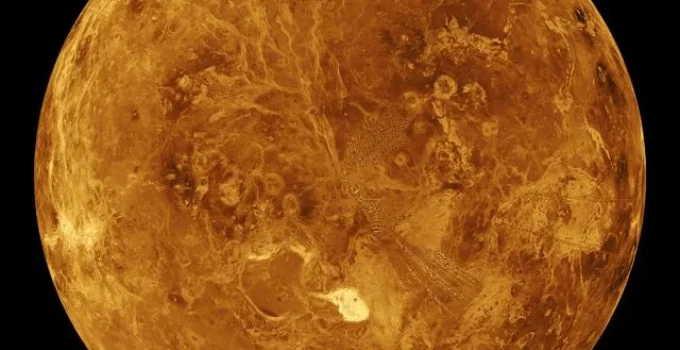What’s the Hottest Planet in the Solar System?
You might think the planet closest to the Sun would be the hottest, but that’s not the case! In this article, we’ll explore which planet really holds the title for hottest in our solar system—and the surprising reason why.
Even though Mercury is the closest planet to the Sun, Venus is actually the hottest! How is that possible? Get ready to learn about Venus’s thick atmosphere, the greenhouse effect, and some mind-blowing temperatures.
🔎 Dive Deeper
- Which Planet Is the Hottest?
- Why Isn’t Mercury the Hottest?
- What Makes Venus So Hot?
- What Is the Greenhouse Effect on Venus?
- How Hot Does Venus Get?
- Could Anything Survive There?
- 🎯Final Thoughts
- 📚References
Which Planet Is the Hottest?
The hottest planet in our solar system is Venus. Even though Mercury is closer to the Sun, Venus beats it in surface temperature because of its thick atmosphere filled with carbon dioxide.
🔥 Venus’s average surface temperature is about 464°C (867°F).
| According to NASA’s planetary fact sheets: NASA Venus Fact Sheet
Why Isn’t Mercury the Hottest?
Mercury is the closest planet to the Sun, so it gets a lot of sunlight. But Mercury has almost no atmosphere, which means it can’t trap heat. Temperatures swing from super hot during the day to freezing cold at night.
- Daytime highs: around 430°C (800°F)
- Nighttime lows: around -180°C (-290°F)
Without an atmosphere, heat escapes back into space.
🌡️ Mercury can drop over 600°C between day and night!
| Data from NASA Solar System Exploration: NASA Mercury Overview
What Makes Venus So Hot?
Venus is farther from the Sun than Mercury, but its atmosphere is over 90 times thicker than Earth’s. That atmosphere is packed with carbon dioxide (CO₂) and covered with clouds of sulfuric acid. These gases trap heat like a giant blanket.
This effect is called the runaway greenhouse effect, and it’s the main reason Venus is the hottest planet.
☁️ Venus’s thick atmosphere reflects 70% of sunlight, but traps nearly all heat beneath it.
| As reported by Science Times.
What Is the Greenhouse Effect on Venus?
The greenhouse effect happens when gases in the atmosphere trap the Sun’s heat. On Earth, this helps keep our planet warm enough for life. But on Venus, it’s gone too far.
Here’s how it works:
| Step | Description |
|---|---|
| 1 | Sunlight passes through the atmosphere. |
| 2 | Venus’s surface absorbs the light and radiates heat. |
| 3 | CO₂ and clouds trap the heat, stopping it from escaping. |
Because of this, Venus’s temperature stays consistently high day and night.
🏜️ Venus has one of the strongest greenhouse effects in the entire solar system.
| Source: European Space Agency: “Greenhouse Effect Also On Other Planets.“
How Hot Does Venus Get?
Venus’s surface temperature is hot enough to melt lead. It’s not just hot during the day—it stays hot all the time.
- Average temperature: 464°C (867°F)
- Highest recorded: Around 470°C (878°F)
- Pressure: 92 times greater than Earth’s (like being 3,000 feet underwater)
Even space probes sent to Venus melt or stop working within hours.
🧪 The Soviet Venera 13 lander lasted just 127 minutes on Venus in 1982 before failing from heat and pressure.
| According to NASA Space Science Data Coordinated Archive
Could Anything Survive There?
So far, no known life can survive on Venus’s surface. The heat, pressure, and toxic air would destroy any spacecraft—or living thing—very quickly. Even machines built to survive extreme conditions have failed.
Some scientists think microbial life might exist high in the clouds, where temperatures and pressures are more Earth-like. But that’s still a mystery.
🔬 In 2020, scientists detected phosphine gas in Venus’s clouds, a possible sign of life.
| Source: Nature Astronomy journal: Greaves et al. 2020
🧪 Venus vs Mercury: Surface Conditions
| Feature | Venus | Mercury |
|---|---|---|
| Average Temperature | 464°C (867°F) | 167°C (332°F) average |
| Atmosphere | Thick (CO₂-rich) | Very thin (mostly oxygen, sodium) |
| Greenhouse Effect | Strong runaway effect | No significant greenhouse effect |
| Day/Night Temp Change | Very little change | Extreme swings (over 600°C difference) |
🎯Final Thoughts
So, what’s the hottest planet in the solar system? It’s not Mercury—it’s Venus, thanks to its runaway greenhouse effect and thick carbon dioxide-filled atmosphere. Venus reminds us how powerful atmospheric conditions can be in shaping a planet’s climate. Even though it’s not the closest to the Sun, Venus is the true “oven” of our solar system.
📚 References
- 💻 NASA. “Venus Fact Sheet.” NASA Planetary Science Division. https://nssdc.gsfc.nasa.gov/planetary/factsheet/venusfact.html
- 💻 NASA. “Mercury Overview.” NASA Solar System Exploration. https://solarsystem.nasa.gov/planets/mercury/overview/
- 💻 Britannica. “5 Weird Facts About Venus.” https://www.britannica.com/list/5-weird-facts-about-venus
- 💻 European Space Agency. “Greenhouse Effects . . . Also On Other Planets.” https://www.esa.int/Science_Exploration/Space_Science/Venus_Express/Greenhouse_effects_also_on_other_planets
- 📝 Greaves, J. S., et al. “Phosphine Gas in the Cloud Decks of Venus.” Nature Astronomy, 2020. https://www.nature.com/articles/s41550-020-1174-4
📌 Learn More About the Planets
- Which Planets Have Rings?🪐Saturn Is Not the Only Sky Princess
- What’s the Order of the Planets (—and Why)?🪐A Solar System Road Map
- What’s the Smallest Planet in the Solar System?🪐Tiny but Mightly in the Cosmic Lineup
- Why Does Mars Look Red? 🪐A Stunning Look at the Science of Rust in Space
- What’s the Largest Planet in the Solar System?🪐Meet the Giant of All Giants
